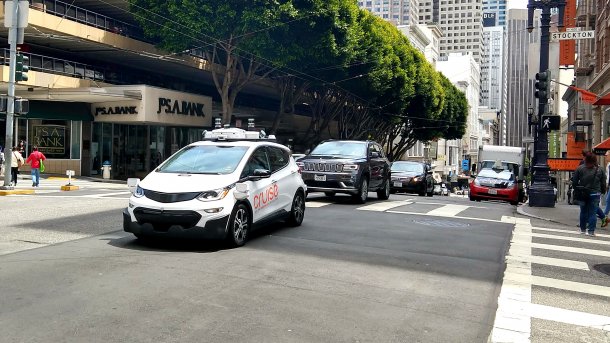Cruise plans limited relaunch of autonomous robotaxis
After an accident, loss of license and the nationwide suspension of all driverless transport, Cruise wants to slowly start operating robotaxis again.

Autonomous vehicle from GM subsidiary Cruise in San Francisco
(Image: Daniel AJ Sokolov)
Just four weeks after suspending all journeys by its autonomous robotaxis, Cruise intends to resume operations of driverless customer transportation on a limited scale. The plan is to restart the robotaxis initially in an as yet undisclosed US city in order to regain trust and prove safe operation before the service is extended to other cities.
This is according to a statement from the General Motors subsidiary, reports the Reuters news agency. Cruise has also announced job cuts for its employees, primarily in non-technical roles. The company intends to announce details in mid-December, as Cruise wrote in an email to its employees.
Just last week, Cruise also took the remaining autonomous cars off the road. Even with a safety person at the wheel, no further journeys will be made for the time being while a full safety check is carried out. This now appears to be almost complete and Cruise is now turning its attention to resuming robotaxi operations.
Loss of license after accident and resignations
California's Department of Motor Vehicles revoked Cruise's license to operate driverless robotaxis on the streets of San Francisco at the end of October. This relates to an incident at the beginning of October when a Cruise autonomous cab hit a woman in downtown San Francisco. The woman was trapped under the vehicle and had to be freed using special equipment after the vehicle dragged her a few meters.
During the subsequent investigation, Cruise did not initially pass on all the camera footage of the vehicle. This even led to Cruise CEO Kyle Vogt and his Chief Product Officer Daniel Kan resigning. Both had founded the self-driving car company in 2013. The company was taken over by GM in March 2016.
Which cars will drive in which city in the future
Cruise is now initially focusing on GM vehicles, the electrically powered Chevrolet Bolt, for its robotaxis. This was sold in Europe by Opel under the name Opel Ampera-e. However, production of this series is to be discontinued at the end of this year. As a successor, Cruise and GM had planned a vehicle without a steering wheel and pedals called "Origin", which was developed jointly with Honda and, according to previous plans, was also to be used in Japan in a few years' time. However, following the accidents at Cruise, GM has suspended construction of the Origin robotaxis for the time being.
Empfohlener redaktioneller Inhalt
Mit Ihrer Zustimmmung wird hier ein externes Video (Kaltura Inc.) geladen.
Ich bin damit einverstanden, dass mir externe Inhalte angezeigt werden. Damit können personenbezogene Daten an Drittplattformen (Kaltura Inc.) übermittelt werden. Mehr dazu in unserer Datenschutzerklärung.
It is still unclear in which US city Cruise will resume its robotaxi operations. It is unlikely to be San Francisco, where the company is headquartered, but where Cruise is known to have lost its license to operate robotaxis. Cruise had previously also offered its autonomous cabs in Phoenix and Austin, where regulators were apparently more accommodating than in California.
(fds)